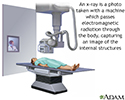Abdominal x-ray
Abdominal film; X-ray - abdomen; Flat plate; KUB x-ray
An abdominal x-ray is an imaging test to look at organs and structures in the abdomen. Organs include the liver, spleen, stomach, and intestines.
When the test is done to look at the bladder and kidney structures, it is called a KUB (kidneys, ureters, bladder) x-ray.
How the Test is Performed
The test may be done in a hospital radiology department. Or, it may be done in the health care provider's office by an x-ray technologist.
You lie on your back on the x-ray table. The x-ray machine is positioned over your abdominal area. You hold your breath as the picture is taken so that the picture will not be blurry. You may be asked to change position to the side or to stand up for additional pictures.
Body parts not being imaged may be covered with a lead apron or shield to limit exposure to the x-rays.
How to Prepare for the Test
Before having the x-ray, tell your provider the following:
- If you are pregnant or think you could be pregnant
- Have had a barium contrast x-ray in the last 4 days
You will wear a hospital gown during the x-ray procedure. You must remove all jewelry.
How the Test will Feel
There is no discomfort. The x-rays are taken as you lie on your back, side, and while standing.
Why the Test is Performed
Your provider may order this test to:
- Diagnose a pain in the abdomen or unexplained nausea
- Identify suspected problems in the urinary system, such as a kidney stone
- Identify blockage in the intestine
- Locate an object that has been swallowed
- Help diagnose diseases, such as tumors or other conditions
Normal Results
The x-ray will show normal structures for a person your age.
What Abnormal Results Mean
Abnormal findings include:
- Abdominal masses
- Buildup of fluid in the abdomen (ascites)
- Certain types of gallstones
- Foreign object in the intestines
- Hole in the stomach or intestines
- Intestinal blockage
- Kidney stones
Risks
There is low radiation exposure. X-rays are monitored and regulated to provide the minimum amount of radiation exposure needed to produce the image. Most experts feel that the risk is low compared to the benefits.
Pregnant women and children are more sensitive to the risks of the x-ray. Women should tell their provider if they are, or may be, pregnant.
References
Sarraf AAA, McLaughlub PD, Maher MM. Current status of imaging of the gastrointestinal tract. In: Adam A, Dixon AK, Gillard JH, Schaefer-Prokop CM, eds. Grainger & Allison's Diagnostic Radiology. 7th ed. Philadelphia, PA: Elsevier; 2021:chap 18.
Tomei E, Cantisani V, Marcantonio A, D'Ambrosio U, Hayano K. Plain radiography of the abdomen. In: Sahani DV, Samir AE, eds. Abdominal Imaging. 2nd ed. Philadelphia, PA: Elsevier; 2017:chap 1.
Review Date: 1/7/2023








